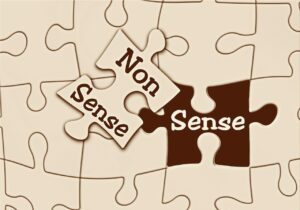It is the earnest desire of parties to a suit that their evidence should be admissible, but not all evidence brought to court would be relevant and admissible. The Nigerian Constitution, the Nigerian Evidence Act, Rules of court, Criminal Procedure Code and Criminal Procedure Act and Common Law are the sources of the Nigerian law of evidence. Up till 1945, the law of evidence applicable in the courts established by the British Government was the English common law of evidence, since there was no local legislation dealing with evidence prior to 1945.
On June 1, 1945, the Evidence Ordinance was brought into operation and has, until this present day, remained almost the same in substance although it has gone through amendments. While the Evidence Act made by the British Colonial Government in 1945 continues in operation as about the only source of the Law of Evidence in the country, developments in such areas as information technology have gone way beyond what that statute could have envisaged at its enactment.
The advent of computer, for instance, brought with it new forms of record keeping in software – microfilms, microchips, diskettes, flash discs etc. that are not by any means within the former understanding of the word “document” which was a written matter on a surface. The simplistic division of documents into originals and copies has also been made unrealistic with respect to several materials used in information transmission and storage.
For instance, when information recorded or stored in the memory of a computer is printed out on paper it is not easy to say that the version in the memory is a document nor is it easy to assert that the print out is an original or a copy (http://Al Chukwuemerie, “Affidavit Evidence and Electronically Generated Materials in Nigerian Courts”, (2006) 3:3 SCRIPT-ed 176 @: <http://www.law.ed.ac.uk/ahrc/script-ed/vol33/affidavit.asp>). Nigerian law of evidence was remarkably slow in recognizing the challenges of proof of electronically –generated evidence. the evidence act 1945 was only amended to recognize e-evidence in 2011. However, the appellate courts had always taken a proactive view despite the constraints of the law (Oluwagbemi Oluwatolani, Abah Joshua and Achimugu Philip (2011) on the impact of information technology in Nigeria’s banking industries. Journal of computer science and engineering, volume 7, issue 2, June 2011).
In perhaps the earliest case on the admissibility of electronic evidence in Nigeria. In Esso West Africa Inc. v. T. Oyegbola (1969) 1 NMLR 194, the supreme court said “the law cannot be and is not ignorant of modern business methods and must not shut its eyes to the mysteries of the computer”. More recently in Federal Republic of Nigeria v. Femi Fani-Kayode (2009) NWLR 236, at the trial of the respondent for money-laundering, a certified copy of the computer generated statement of account of the respondent was to be tendered as evidence. The respondent opposed the application on the ground that the computer generated statement of account is inadmissible under section 97 of the evidence act. The learned trial judge upheld the objection and rejected the statement of account.
*Note that this decision has been set aside by the Court of Appeal in a Judgement delivered on Thursday 27th May, 2010. The Court held that the document in question was admissive. The Supreme Court has also affirmed the judgement of the Court of Appeal recently.
Evidence they say is the law. This assertion is in every ramification true as the law finds expression only in the evidence alluded to it. On this ground therefore, every jurisdiction tends to have a uniform code on the rules of evidence. In Nigeria, we had the Evidence Ordinance way back in 1945. Amazingly, that ordinance survived time with little or no alterations despite the radical evolution in the 21st century vis-a-vis Information Technology.
Evidence is a legally admissible fact and the legal means of proving that fact excluding inferences, prayers and arguments. It is the art of evidence that determine which fact the court should admit and the manner of establishing that fact. Evidence is the means by which facts are proved, but excluding inferences and arguments. It is common knowledge that a fact can be proved by the oral testimonies of persons who perceived the fact, or by production of documents, or by inspection of things or places, all these will come within the meaning of judicial evidence.
On a very broad view, it is permissible to include in this list such other means of proving a fact as admissions and confessions, judicial notice, presumptions and estoppels. In legal parlance, the term ‘evidence’ includes all the means by which an alleged matter of fact, the truth of which is submitted to investigation, is established or disproved. Evidence’ has also been defined to mean any species of proof legally presented at the trial of an issue, by the act of the parties and through the medium of witnesses, records, documents or concrete objects, and the like.
Electronic and computer generated evidence is a generic description for certain classes of evidence processed, stored or derived from computers or computer based devices or electronic communication systems. A major characteristic of this class of documents is that unless printed, they are paperless and though contained in tangible objects are visible but intangible. Computer-produced evidence is generally inadmissible because they are not original, they often are hearsay under the rule of evidence or have for their form been rendered inadmissible in court although, the 2011 amendment have taken cognizance of the need to find a way around computer-produced evidence.
In the case of Anyaebosi & Ors v. R.T. Briscoe Nig. Ltd (1987)2NSCC 805, the Supreme Court endorsed the admissibility of computer printout as secondary evidence. The court held that computerized statements of account, after all are not in the class of evidence which are completely excluded by the Evidence Act. Therefore, the computerized statement in issue in that case was rightly admitted as secondary evidence. In the above case, the plaintiff entered into an agency agreement with the defendant for the sale of some goods.
The only means of proof or record of sales transactions was some computer printout certified by the official who was in charge of recording such transactions. In an action for the recovery of various sums of money, which were the proceeds of the sales of the goods the plaintiff presented the computer printout as evidence without any objection by the defendant and the court admitted it in evidence. However, on appeal by the defendant, it was contended that the computer printouts were wrongly admitted as evidence on the basis that they were prepared by a person interested at the time in anticipation of the proceedings.
At the Supreme Court, it was argued that the evidence i.e. the computer printout was wrongly admitted in evidence contrary to section 96(2) of the old Evidence Act. It was held that the computer printout i.e. statement of account does not fall within the category of evidence absolutely inadmissible by law as it is admissible as secondary evidence under Section 96(2) of the Evidence Act in respect of the documents stated in Section 96(1)(d).
In Nigeria, Section 93 of the Evidence Act 2010 dictates mode of proof of documents as either by primary or secondary evidence. Primary means the document itself produce for inspection of the court that original document. The historical imperative that impelled the revolution of the primary evidence were dictated by expediency of obviating the drudgery of transliteration in the attendance of error and forgery, therefore the rule has a very long history dating back to the days when all copying of documents had to be done by hand, and the scope for mistakes and forgeries was considerable subject to the risk of inaccuracy associated with manual copying or with a witness giving oral evidence of the content of a document from memory.
The advent of technology, has supplanted the logic of that historical exigency. The development has prompted a liberal approach through the interpretation of the primary evidence rule. Thus, in Kajala v. Noble (1982) 75 CR APP R. 149, the divisional court held that the primary evidence rule only applies to written documents in the strict sense and did not apply to new category of documents, tapes and films.” In this case, the court upheld the admissibility of a video recording of the original BBC news film which show the defendant taking part in a riot.
However, Section 258 (1) of the 2011 Evidence Act, defines a computer as “any device for storing and processing information, and any reference to information being derived from other information is a reference to its being derived from it by calculation, comparison or any other process;” While Section 258 (1) of the Act, expanded the scope of the definition of a document to include:
(a) books, maps, plans, graphs, drawings, photographs, and also includes any matter expressed or described upon any substance by means of letters, figures or marks or by more than one of these means, intended to be used or which may be used for the purpose of recording that matter;
(b) any disc, tape, sound track or other device in which sounds or other data (not being visual images) are embodied so as to be capable (with or without the aid of some other equipment) of being reproduced from it, and
(c) any film, negative, tape or other device in which one or more visual images are embodied so as to be capable (with or without the aid of some other equipment) of being reproduced from it; and
(d) any device by means of which information is recorded, stored or retrievable including computer output:
Similarly, Section 258 (1) of the 2011 Evidence Act, unlike the old Act defines a “Copy of a Document” to include:
(a) in the case of a document falling within paragraph (b) but not (c) of the definition of “document” in this subsection, a transcript of the sounds or other data embodied in it;
(b) in the case of a document falling within paragraph (b) but not (c) of that definition, a reproduction or still reproduction of the image or images embodied in it whether enlarged or not;
(c) in the case of a document falling within both those paragraphs, such a transcript together with such a still reproduction; and
(d) in the case of a document not falling within the said paragraph (c) of which a visual image is embodied in a document falling within that paragraph, a reproduction of that image, whether enlarged on not, and any reference to a copy of the material part of a document shall be construed accordingly.
Against the foregoing and with the benefit of hindsight, it is crystal clear that the narrow definition of “document” under section 2 of the evidence Act, 2004 and the non-definition of the word “computer” in the same statute gave rise to the controversy whether computer generated evidence was admissible or not in our courts and if they are admissible, whether as primary or secondary evidence.
With the nascent evidentiary rules introduced by the Evidence Act, 2011, the shortcomings that existed in the above cases no longer arise because Section 51 of the Evidence Act, 2011 now succinctly provides that “entries in books of accounts or electronic records regularly kept in the course of business are admissible whether they refer to a matter into which the court has to inquire, but such statements shall not alone be sufficient to charge any person with liability”. So without any doubt or any ambiguity, “computer outputs” are documents provided for in our statute books as admissible primary evidence on their own merit once the conditions precedent are met.
Relevant statements in documents produced by computers are admissible subject to conditions precedent being met. These four conditions precedent are:
(a) that the document containing the statement was produced by the computer during a period over which the computer was used regularly to store or process information for the purposes of any activities regularly carried on over that period, whether for profit or not, by anybody, whether corporate or not, or by any individual;
(b) that over that period there was regularly supplied to the computer in the ordinary course of those activities information of the kind contained in the statement or of the kind from which the information so contained is derived;
(c) that throughout the material part of that period the computer was operating properly or, if not, that in any respect in which it was not operating properly or was out of operation during that part of that period was not such as to affect the production of the document or the accuracy of its contents; and
(d) that the information contained in the statement reproduces or is derived from information supplied to the computer in the ordinary course of those activities.
These four conditions precedent for admissibility of a statement contained in a document produced by a computer were considered by the Supreme Court in the recent case of Dr. Imoro Kubor & Anor. v. Hon Seriake Henry Dickson & Ors (2012) LPELR-SC 369/2012, where the eminent jurist, Onnoghen, J.S.C expounded that, the above conditions precedent were the pre-conditions laid down by the law and consequently, held that, the two computer generated documents in issue were not admissible in evidence on the ground that, the said four conditions precedent were not satisfied by the Appellant. In the words of the Learned Justice:
‘There is no evidence on record to show that appellants in tendering Exhibits “D” and “L” satisfied any of the above conditions. In fact, they did not as the documents were tendered and admitted from the bar. No witness testified before tendering the documents so there was no opportunity to lay the necessary foundations for their admission as e-documents under Section 84 of the Evidence Act, 2011. No wonder therefore that the lower court held, at page 838 of the record thus: – “A party that seeks to tender in evidence a computer generated document needs to do more than just tendering same from the bar. Evidence in relation to the use of the computer must be called to establish the conditions set out under Section 84(2) of the Evidence Act, 2011. I agree entirely with the above conclusion. Since appellants never fulfilled the pre-conditions laid down by law, Exhibits “D” and “L” were inadmissible as computer generated evidence/documents.”’
Section 84 (4) of the Act provides that: “In any proceeding where it is desired to give a statement in evidence by virtue of this section, a certificate
(a) identifying the document containing the statement and describing the manner in which it was produced;
(b) giving such particulars of any device involved in the production of that document as may be appropriate for the purpose of showing that the document was produced by a computer.
(i) dealing with any of the matters to which the conditions mentioned in subsection (2) above relate, and purporting to be signed by a person occupying a responsible position in relation to the operation of the relevant device or the management of the relevant activities, as the case may be, shall be evidence of the matter stated in the certificate; and for the purpose of this subsection it shall be sufficient for a matter to be stated to the best of the knowledge and belief of the person stating it.”
In the case of Kubor & Anor. v. Dickson & Ors (supra), the issue of the certificate stated in Section 84 (4) was not an issue rather His Lordship referred to the failure of the Appellant to lay the necessary foundation for the admission of e-documents under Section 84 of the Evidence Act. It is submitted that, in the absence of the certificate referred to in Section 84(4), if a witness is a person occupying a responsible position in relation to the operation of the computer by which a document was generated, such a witness may be led in evidence to lay the necessary foundation of the particulars required to be in the certificate.
It should be noted that our Section 84(2) is very similar to the position in England on the admissibility of computer generated evidence. This is not surprising since most of our legislations take a cue from that of England. Thus in R v Spilby (1991) Crim LR, 199, it was held that the computer print- out were real evidence. Also in R v Blackburn (1992) Crim LR, 123, the English Court of Appeal held the view that where the computer is used for word processing, a document produced thereby should be regarded as having been produced by a human being with the aid of computer. If documents made by one uniform process, then each of the documents are originals.




